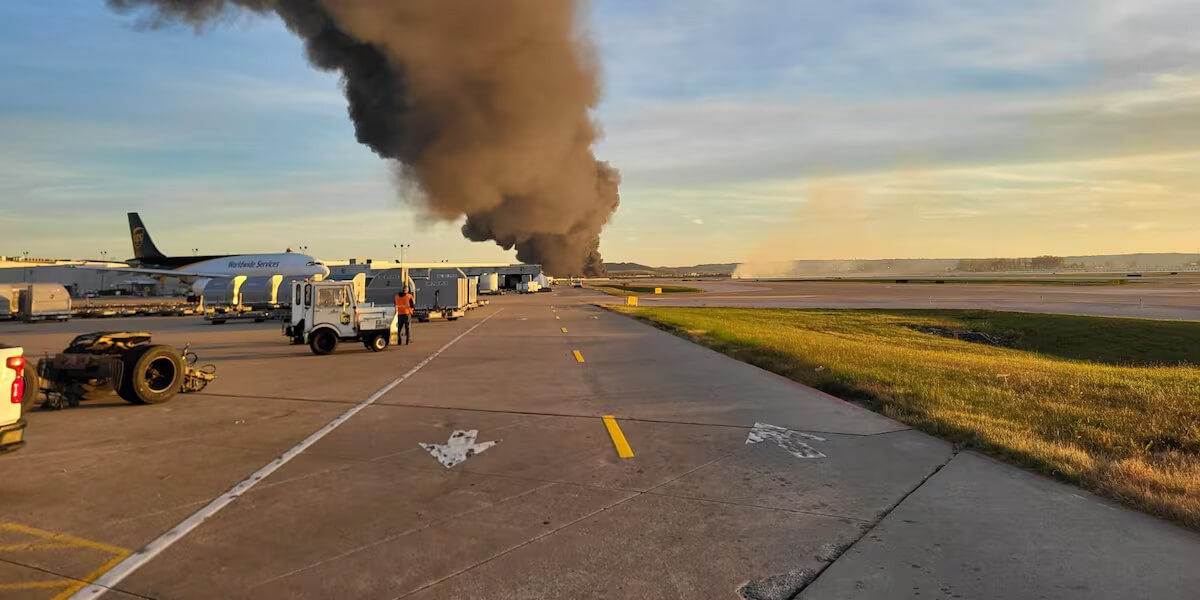1. The Incident: What Happened
On Tuesday, November 4, 2025, a cargo plane operated by UPS flight number UPS Flight 2976, a McDonnell Douglas MD-11F registered N259UP, took off from runway 17R at Louisville Muhammad Ali International Airport, bound for Honolulu, Hawaiʻi.
Shortly after liftoff, videos captured a plume of fire erupting from the left wing of the aircraft, and investigators say the left engine detached during takeoff.
The plane briefly became airborne, cleared the airport fence, but then crashed into industrial structures just beyond the airport perimeter, resulting in a debris field approximately a half-mile in length.
As of the latest update, the death toll stands at 12 confirmed, including one child; several people on the ground remain unaccounted for.
2. Location & Airport Context
The crash occurred near the world-famous UPS air freight hub known as Worldport in Louisville, Kentucky. This facility handles thousands of packages hourly and is a critical node in UPS’s global logistics network.
Given the location immediately adjacent to runways and industrial buildings the impact extended beyond just the aircraft: multiple businesses in the vicinity were damaged or engulfed in fire, and emergency-response teams described “explosion after explosion” as the fire spread.
3. Victims & Human Toll
Three crew members were aboard the flight when it departed. At this time, authorities have not confirmed whether the crew are among the fatalities or the injured.
Additional casualties include ground-workers and nearby business employees; a child has been confirmed among the deceased.
Hospitals in the area received at least 15 patients, of whom 13 have already been discharged; two remained in critical condition.
The scale of the destruction and damage made identification of victims “more difficult,” according to the governor.
4. Investigation: What Clues Have Emerged
The investigation into the crash is being led by the National Transportation Safety Board (NTSB) alongside the Federal Aviation Administration (FAA).
Key pieces of evidence have already been recovered: the cockpit voice recorder (CVR) and flight data recorder (FDR) were retrieved from the wreckage. The Washington Post
One significant technical finding: video shows the left engine detaching from the wing during takeoff, and a fire developing on the wing prior to impact.
Investigators face a complex terrain: the debris field spans half a mile, multiple business structures were hit, and the presence of jet fuel and industrial materials complicates fire-scene management.
While a preliminary cause (engine separation) is identified, a full determination will take more than a year, per NTSB statements.
5. Operational & Business Impact
Because the crash occurred at UPS’s major hub, the operational fallout has been immediate and broad. The Worldport facility halted sorting operations following the crash, affecting national and international shipping flows.
This hub shut-down is impacting not only UPS internal logistics but also partner shipping flows for multiple major retailers and commercial supply-chains heading into the holiday season.
On-site, emergency-response units mobilized more than a hundred fire-trucks and responders; businesses in the disaster area were evacuated, shelter-in-place orders issued, and schools were closed in the affected district.
6. Community & Response
Local and state officials declared a state of emergency. First-responders and community volunteers have been assisting in search, rescue, and debris management. Business owners near the crash site described scenes of chaos and uncertainty amid the explosions and fire.
A reunification centre was set up for families of the missing; authorities are urging residents not to touch wreckage or debris and to report found mail or materials through official channels.
Nationally, there is an outpouring of support: political leaders, aviation industry bodies and civil society organisations have offered condolences and pledged cooperation in the investigation and recovery efforts. Wikipedia
7. Safety & Regulatory Implications
This crash raises urgent safety questions:
How did a major cargo aircraft experience engine separation at takeoff?
What maintenance, inspection or design factors may have contributed?
How will regulators respond to ensure cargo-plane safety under heavy loads with fuel and takeoff stress?
The NTSB investigation will set in motion potential findings that could lead to regulatory changes, industry-wide inspections, and perhaps redesign or retrofit of aircraft older models like the MD-11F.
The broader supply-chain and logistic industries will also scrutinise hub-operations near populated or industrial areas and the contingency planning for high-volume freight operations.
8. What Comes Next
In the days and weeks to follow:
Investigators will analyse the CVR/FDR data, maintenance records for the aircraft, and video/surveillance of the takeoff.
A detailed debris-mapping and metallurgical examination of the engine, wing, fuel systems and structures will be required.
UPS and its insurers will coordinate with families of victims, and regulatory oversight may intensify for the cargo-aviation sector.
Operational impact: rerouting, capacity shifts, logistical delays may persist; customers are urged to monitor tracking updates.
Community recovery: cleanup of the crash-site, environmental checks, and rebuilding of affected businesses will take time.
Policy discussion: How to balance growth in e-commerce freight aviation with safety, proximity to industrial zones, and risk management.
Conclusion
The crash of UPS Flight 2976 near Louisville is a devastating tragedy with loss of life, infrastructure damage, and wide-ranging implications. While the immediate focus is rescue and recovery, the incident will catalyse questions about aircraft age, maintenance protocols, cargo-hub safety, and the interconnectedness of global logistics systems. For the families affected, the community of Louisville, and the broader aviation-freight world, the ripples will be felt for a long time. As investigators piece together what happened, the lessons learned will shape the future of cargo flight safety and hub operations.



